
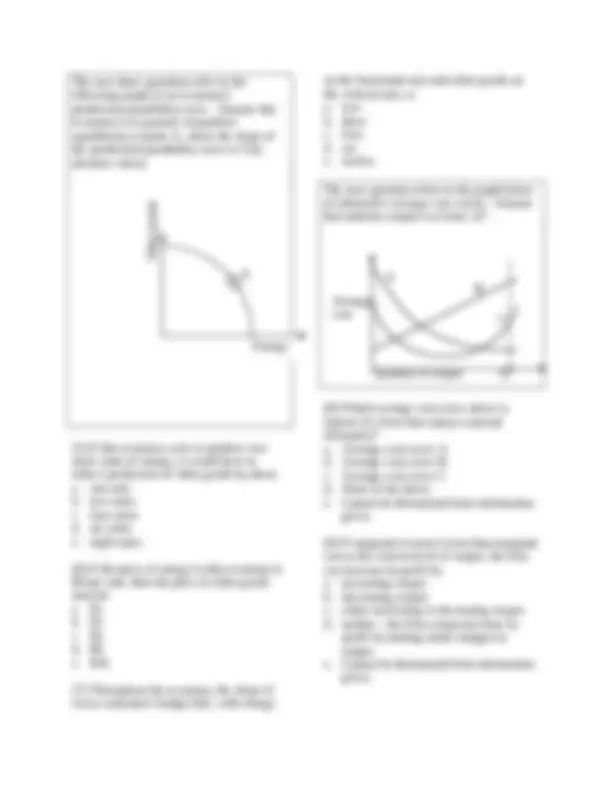
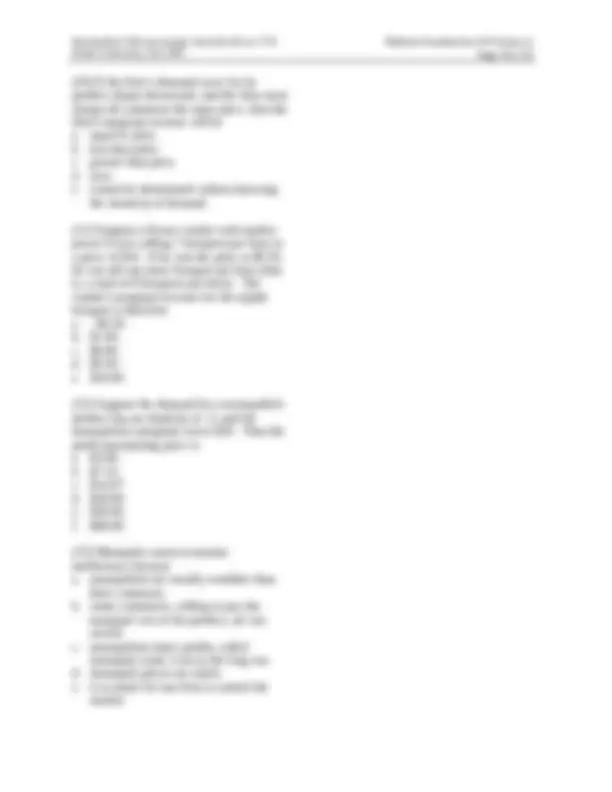
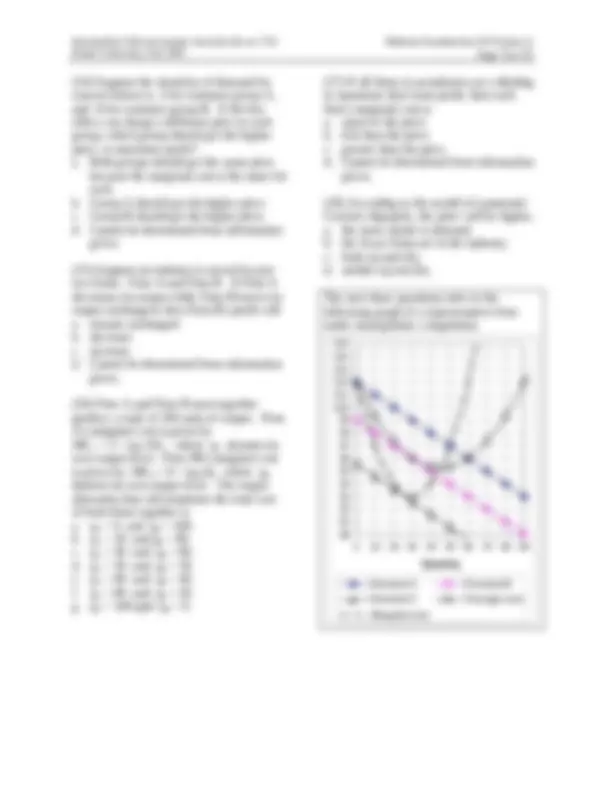
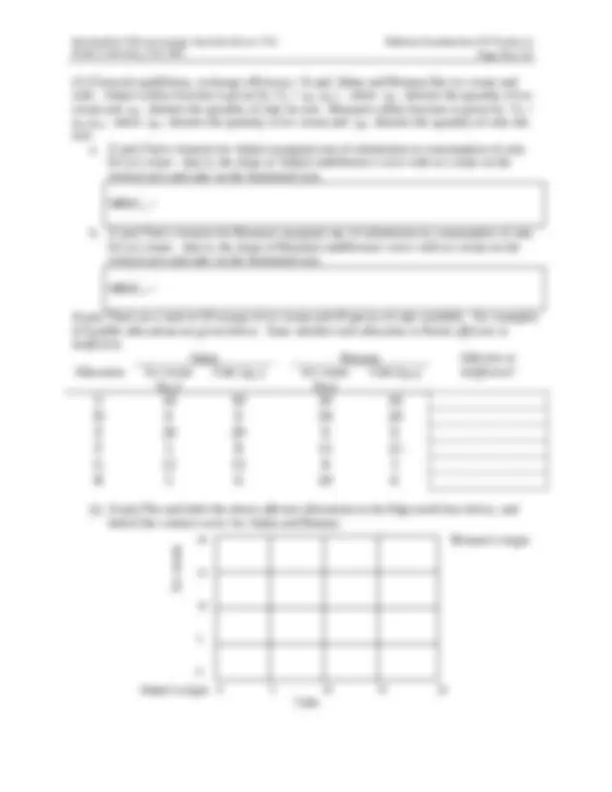
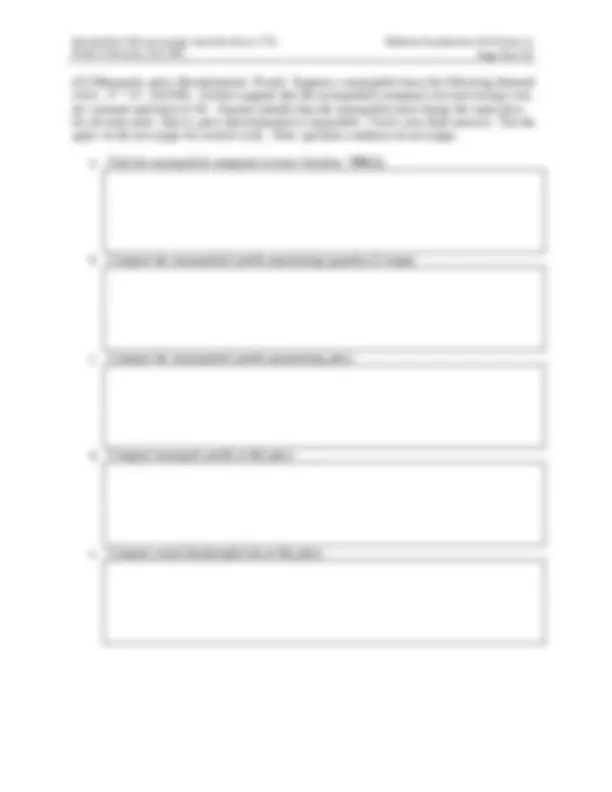
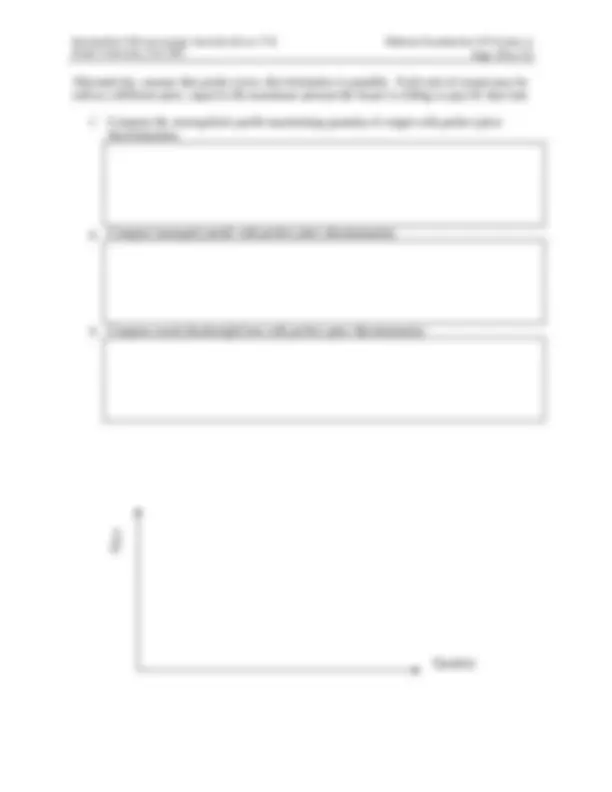
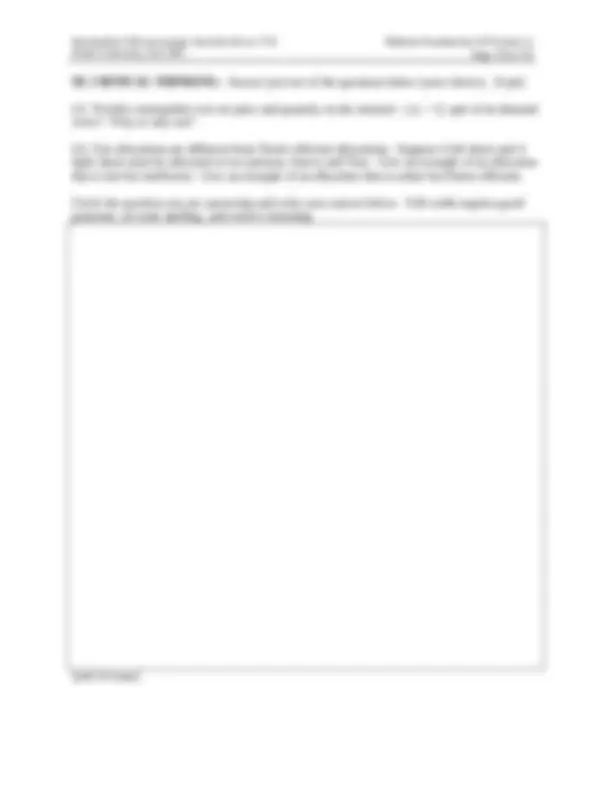


Study with the several resources on Docsity

Earn points by helping other students or get them with a premium plan


Prepare for your exams
Study with the several resources on Docsity

Earn points to download
Earn points by helping other students or get them with a premium plan
Community
Ask the community for help and clear up your study doubts
Discover the best universities in your country according to Docsity users
Free resources
Download our free guides on studying techniques, anxiety management strategies, and thesis advice from Docsity tutors
A midterm examination for the intermediate microeconomic analysis (econ 173) course at drake university, fall 2007. It covers topics such as general equilibrium, exchange efficiency, monopoly, price discrimination, and cournot duopoly.
Typology: Exams
1 / 13

This page cannot be seen from the preview
Don't miss anything!








Intermediate Microeconomic Analysis (Econ 173) Signature: Drake University, Fall 2007 William M. Boal Printed name:
INSTRUCTIONS: This exam is closed-book, closed-notes. Simple calculators are permitted, but not graphing calculators or calculators with alphabetical keyboards. Point values for each question are noted in brackets. As usual in this course, “ exp(x) ” denotes the exponential function (also written ex^ ) while “ ln(x) ” denotes the natural logarithm function (logarithm to base e = 2.7182818…). I. MULTIPLE CHOICE: Circle the one best answer to each question. Feel free to use margins for scratch work. [2 pts each—52 pts total] The next three questions refer to the following Edgeworth box diagram. The solid curves are Jennifer's indifference curves. The dashed curves are Ryan's indifference curves. (1) From allocation B, both people can be made better off if a. Jennifer gives Ryan some food, and Ryan gives Jennifer some clothing. b. Jennifer gives Ryan some clothing, and Ryan gives Jennifer some food. c. Either (a) or (b). d. No trade can make both people better off. Jennifer Ryan Clothing Food
Drake University, Fall 2006 Page 2 of 13 (2) From allocation C, both people can be made better off if a. Jennifer gives Ryan some food, and Ryan gives Jennifer some clothing. b. Jennifer gives Ryan some clothing, and Ryan gives Jennifer some food. c. Either (a) or (b). d. No trade can make both people better off. (3) Jennifer and Ryan have identical marginal rates of substitution in consumption at a. allocation B only. b. allocation C only. c. both allocations B and C. d. neither allocations B nor C. (4) The contract curve for this Edgeworth box diagram would not pass through a. Allocation A. b. Allocation B. c. Allocation C. d. The contract curve passes through all three allocations. e. The contract curve does not pass through any of these three allocations.
Drake University, Fall 2007 Page 4 of 13 (10) If the firm’s demand curve for its product slopes downward, and the firm must charge all customers the same price, then the firm's marginal revenue will be a. equal to price. b. less than price. c. greater than price. d. zero. e. cannot be determined without knowing the elasticity of demand. (11) Suppose a flower vendor with market power is now selling 7 bouquets per hour at a price of $10. If he cuts the price to $9.50, he can sell one more bouquet per hour (that is, a total of 8 bouquets per hour). The vendor's marginal revenue for the eighth bouquet is therefore a. - $0.. b. $1.. c. $6.. d. $9.. e. $10.. (12) Suppose the demand for a monopolist's product has an elasticity of -3, and the monopolist's marginal cost is $20. Then the profit-maximizing price is a. $3.. b. $7.. c. $14.. d. $20.. e. $30.. f. $60.00. (13) Monopoly causes economic inefficiency because a. monopolists are usually wealthier than their customers. b. some consumers, willing to pay the marginal cost of the product, are not served. c. monopolists enjoy profits, called monopoly rents, even in the long run. d. monopoly prices are unfair. e. it is unfair for one firm to control the market.
Drake University, Fall 2007 Page 5 of 13 (14) Suppose the elasticity of demand for concert tickets is -3 for customer group A, and -8 for customer group B. If the box office can charge a different price to each group, which group should get the higher price, to maximize profit? a. Both groups should get the same price because the marginal cost is the same for each. b. Group A should get the higher price. c. Group B should get the higher price. d. Cannot be determined from information given. (15) Suppose an industry is served by just two firms: Firm A and Firm B. If Firm A decreases its output while Firm B leaves its output unchanged, then Firm B's profit will a. remain unchanged. b. decrease. c. increase. d. Cannot be determined from information given. (16) Firm A and Firm B must together produce a total of 100 units of output. Firm A's marginal cost is given by MCA = 5 + (qA/10) , where qA denotes its own output level. Firm #B's marginal cost is given by MCB = 8 + (qB/4), where qB denotes its own output level. The output allocation that will minimize the total cost of both firms together is a. qA = 0 and qB = 100. b. qA = 20 and qB = 80. c. qA = 40 and qB = 60. d. qA = 50 and qB = 50. e. qA = 60 and qB = 40. f. qA = 80 and qB = 20. g. qA = 100 qnd qB = 0. (17) If all firms in an industry are colluding to maximize their total profit, then each firm's marginal cost is a. equal to the price. b. less than the price. c. greater than the price. d. Cannot be determined from information given. (18) According to the model of symmetric Cournot oligopoly, the price will be higher, a. the more elastic is demand. b. the fewer firms are in the industry. c. both (a) and (b). d. neither (a) nor (b). The next three questions refer to the following graph of a representative firm under monopolistic competition. $ $ $ $ $ $ $ $ $ $ $ $ $ $ $ $ 0 10 20 30 40 50 60 70 80 90 Quantity Demand A Demand B Demand C Average cost Marginal cost
Drake University, Fall 2007 Page 7 of 13 The next five questions refer to the following game. Firms A and B produce competing brands. Each firm finds that advertising is costly but helps attract customers away from its rival. Firm B Advertise Do not advertise Firm A Adver- tise A gets $ million. B gets $ million. A gets $ million. B gets $ million. Do not adver- tise A gets $ million. B gets $ million. A gets $ million. B gets $ million. (22) How many Pareto-optimal outcomes are there in this game? a. Zero. b. One. c. Two. d. Three e. Four. (23) What is Firm A's dominant strategy? a. Advertise. b. Do not advertise. c. Both (a) and (b). d. Firm A has no dominant strategy. (24) What is Firm B's best reply if Firm A chooses not to advertise? a. Advertise. b. Do not advertise. c. Both (a) and (b). d. Firm B has no best reply if Firm A chooses not to advertise. (25) What is the dominant-strategy equilibrium of this game? a. Firm A advertises, Firm B does not advertise. b. Firm A does not advertise, Firm B advertises. c. Both firms advertise. d. Neither firm advertises. e. This game has no dominant-strategy equilibrium. (26) What is the Nash equilibrium of this game? a. Firm A advertises, Firm B does not advertise. b. Firm A does not advertise, Firm B advertises. c. Both firms advertise. d. Neither firm advertises. e. This game has no Nash equilibrium in pure strategies. II. PROBLEMS: Please write your answers in the boxes on this question sheet. Show your work and circle your final answers.
Drake University, Fall 2007 Page 8 of 13 (1) [General equilibrium, exchange efficiency: 14 pts] Adam and Brianna like ice cream and cake. Adam's utility function is given by UA = q1A q2A^2 , where q1A denotes the quantity of ice cream and q2A denotes the quantity of cake he eats. Brianna's utility function is given by UB = q1B q2B, where q1B denotes the quantity of ice cream and q2B denotes the quantity of cake she eats. a. [2 pts] Find a formula for Adam's marginal rate of substitution in consumption of cake for ice cream—that is, the slope of Adam's indifference curve with ice cream on the vertical axis and cake on the horizontal axis. MRSCA = b. [2 pts] Find a formula for Brianna's marginal rate of substitution in consumption of cake for ice cream—that is, the slope of Brianna's indifference curve with ice cream on the vertical axis and cake on the horizontal axis. MRSCB = [6 pts] There are a total of 20 scoops of ice cream and 20 pieces of cake available. Six examples of feasible allocations are given below. State whether each allocation is Pareto efficient or inefficient. Adam Brianna Efficient or Allocation Ice cream (q1A) Cake (q2A) Ice cream (q1B) Cake (q2B) inefficient?
(i) [4 pts] Plot and label the above efficient allocations in the Edgeworth box below, and sketch the contract curve for Adam and Brianna. Adam’s origin Brianna’s origin 0 5 10 15 20 20 15 10 5 0 Ice cream Cake
Drake University, Fall 2007 Page 10 of 13 Alternatively, assume that perfect price discrimination is possible. Each unit of output may be sold at a different price, equal to the maximum amount the buyer is willing to pay for that unit. f. Compute the monopolist's profit-maximizing quantity of output with perfect price discrimination. g. Compute monopoly profit with perfect price discrimination. h. Compute social deadweight loss with perfect price discrimination. Quantity Price
Drake University, Fall 2007 Page 11 of 13 (3) [Cournot duopoly: 14 pts] Suppose two firms form a (symmetric) Cournot duopoly, each firm setting its own quantity while taking the other firm’s quantity as given. Let q 1 = firm #1’s quantity and q 2 = firm #2’s quantity, so that total market quantity Q = q 1 + q 2. The market demand curve is P = 15 – (Q/100). Each firm has constant marginal and average cost equal to $3. Circle your final answers. Use the space on the next page for scratch work. Note: question continues on next page. a. Find an expression for firm #1's revenue, as a function of its own quantity and the quantity produced by the other firm: Rev 1 (q 1 ,q 2 ). [Hint: By definition, Rev 1 = P q 1. Here, replace P by the equation for the demand curve, and then replace Q by (q 1 + q 2 ).] b. Find an expression for firm #1's marginal revenue, as a function of its own quantity and the quantity produced by the other firm: MR 1 (q 1 ,q 2 ). [Hint: MR 1 (q 1 ,q 2 ) = Rev 1 (q 1 ,q 2 ) / q 1 .] c. Find an expression for firm #1's reaction function, showing how much firm #1 will produce for any given level of quantity set by the other firm: q 1 * = f(q 2 ). [Hint: Set MR 1 = MC and solve for q 1 as a function of q 2 .] d. Assume the equilibrium is symmetric (that is, assume q 1 * = q 2 *) and compute firm #1's equilibrium quantity q 1 *.
Drake University, Fall 2007 Page 13 of 13 III. CRITICAL THINKING: Answer just one of the questions below (your choice). [4 pts] (1) Would a monopolist ever set price and quantity on the inelastic ( |ε| < 1) part of its demandε|ε| < 1) part of its demand < 1) part of its demand curve? Why or why not? (2) Fair allocations are different from Pareto efficient allocations. Suppose 4 left shoes and 4 right shoes must be allocated to two persons, Stacey and Tom. Give an example of an allocation that is fair but inefficient. Give an example of an allocation that is unfair but Pareto efficient. Circle the question you are answering and write your answer below. Full credit requires good grammar, accurate spelling, and correct reasoning. [end of exam]